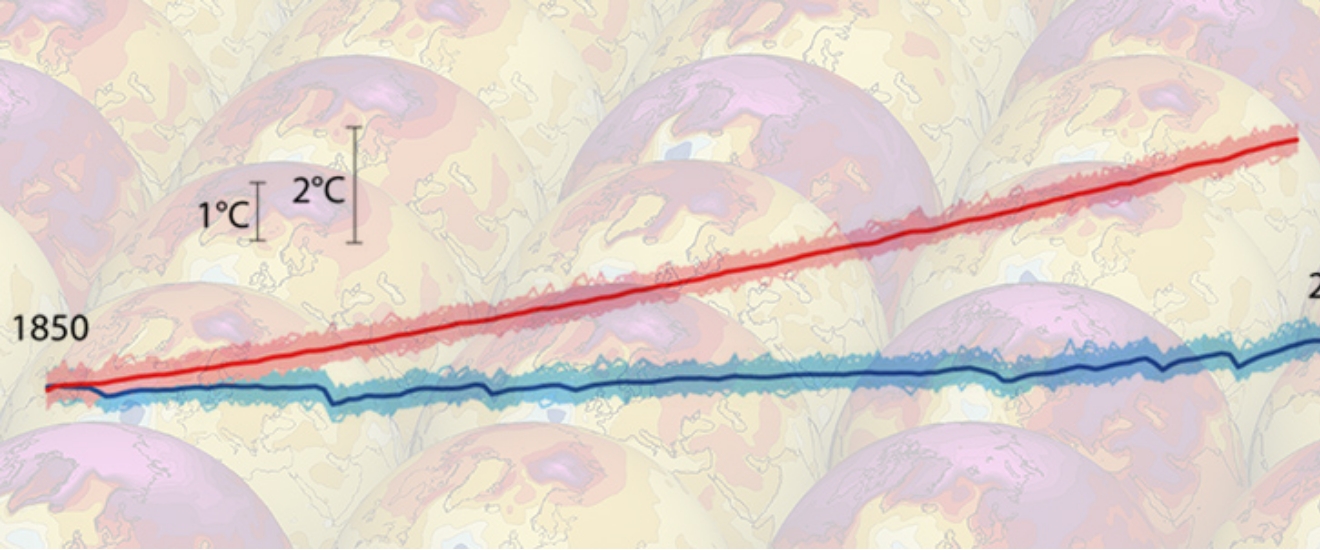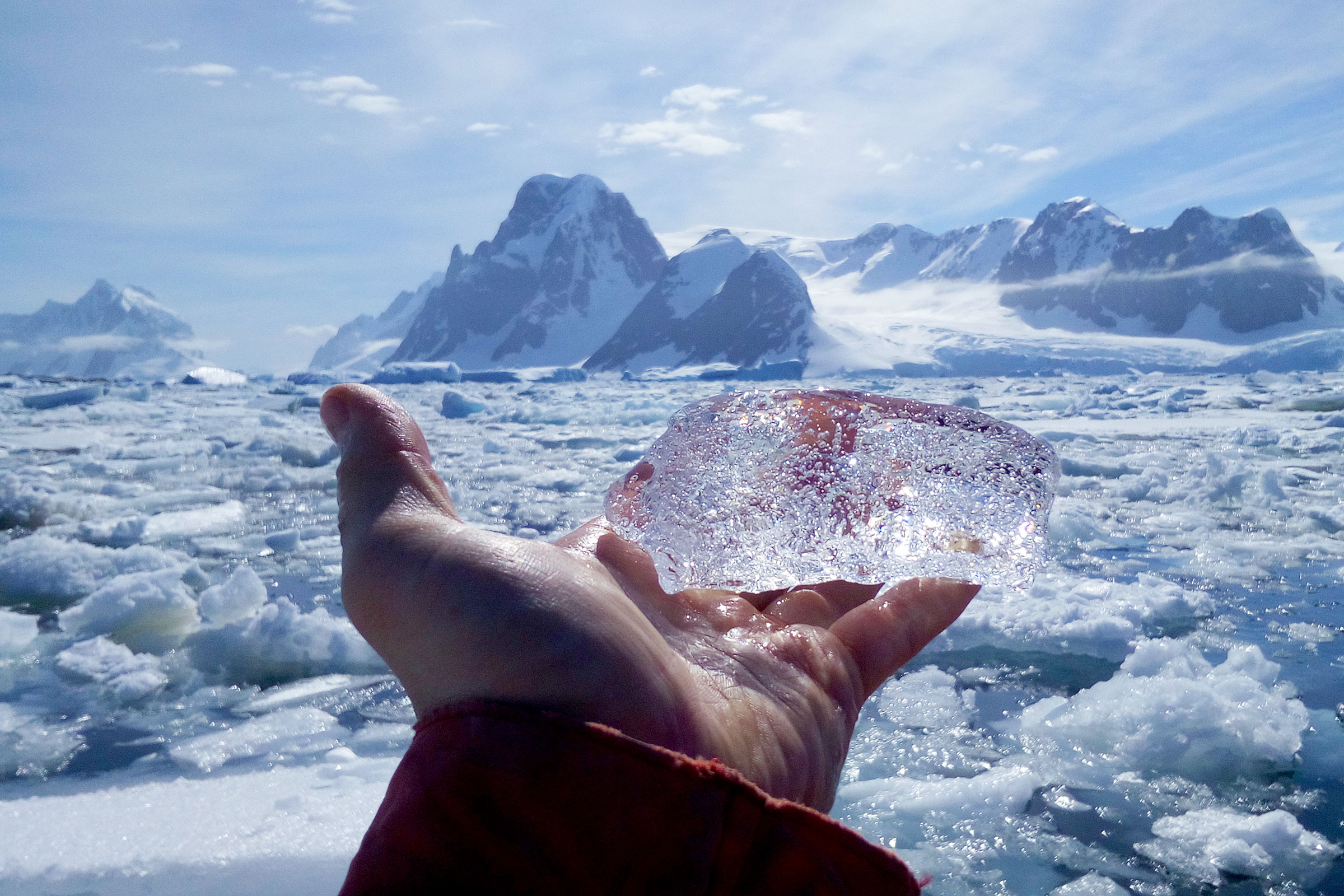
Wie kann ich auf die MPI-GE-Daten zugreifen und sie zitieren?
Derzeit sind Daten über Atmosphäre, Land, Meereis und Ozean (einschließlich einiger biogeochemischer Variablen) verfügbar.
Um die Daten zu nutzen, muss zunächst die Lizenz akzeptiert werden, die hier zu finden ist.
Alternativ dazu erscheint beim direkten Download einer Datei die Lizenzvereinbarung. Nachdem die Lizenz akzeptiert wurde, funktioniert der wget-Download. Bitte beachten Sie, dass diese Skripte nicht funktionieren, wenn der Safari-Browser verwendet wird.
Die linke Seite der Webseite kann für die Suche nach Variablen verwendet werden, ebenso wie die Leiste am oberen Rand. Um zum Beispiel nach Niederschlag im RCP8.5-Szenario zu suchen, kann man 'pr AND RCP8.5' in die Suchleiste eingeben. Der effizienteste Weg, das gesamte Ensemble herunterzuladen, besteht darin, nach den gewünschten Daten zu suchen und dann auf "Alle angezeigten Ergebnisse zum Datenkorb hinzufügen" zu klicken. Gehen Sie von hier aus in den Datenkorb und klicken Sie auf "Select All Datasets". Erstellen Sie dann ein wget-Skript für diesen Download. Zum Ausführen des wget-Skripts kann der folgende Befehl verwendet werden: $ bash wget-xxx.sh -H
Die Daten werden 10 Jahre lang ab der Veröffentlichung (Ende 2028) verfügbar sein.
Wissenschaftler, die die Daten nutzen möchten, bevor sie öffentlich zugänglich sind, können mit Wissenschaftlern des Max-Planck-Instituts zusammenarbeiten.
Bitte zitieren Sie die folgende Veröffentlichung, wenn Sie die Daten verwenden:
Maher, N., Milinski, S., Suarez-Gutierrez, L., Botzet, M., Dobrynin, M., Kornblueh, L., Kröger, J., Takano, Y., Ghosh, R., Hedemann, C., Li, C., Li, H., Manzini, E., Notz, N., Putrasahan, D., Boysen, L., Claussen, M., Ilyina, T., Olonscheck, D., Raddatz, T., Stevens, B. und Marotzke, J. (2019). The Max Planck Institute Grand Ensemble: Enabling the Exploration of Climate System Variability. Journal of Advances in Modeling Earth Systems, 11, 1-21. doi.org/10.1029/2019MS001639
Bitte senden Sie eine E-Mail an grandensemble@mpimet.mpg.de, wenn Sie eine Arbeit unter Verwendung der Daten veröffentlichen, Fehler oder Bugs in den Daten finden oder Daten anfordern möchten, die derzeit nicht verfügbar sind.
Die Daten sind derzeit auf dem nativen Grid verfügbar. Wir empfehlen CDO als Werkzeug für die Neueinteilung von Rastern, die Auswahl von Unterregionen, die Auswahl von Zeiträumen und vieles mehr. Es ist schnell, effizient und kann in Skriptsprachen (bash, python) verwendet werden, um auf einfache Weise Schleifen über Ensemblemitglieder zu ziehen. CDO kann hier gefunden werden.
Gemeinsame Projekte mit MPI-M
Die SMILE-Gruppe (Single Model Initial-condition Large Ensemble) wurde zusammen mit Kollegen von der LMU München, der University of Reading und dem NCAR ins Leben gerufen, um ein Forum für den Austausch und die Diskussion in der großen Ensemble-Gemeinschaft zu schaffen.
Die offene SMILE Mailingliste ist unter https://large-ensemble.github.io/mailinglist/ zu finden
Das erste SMILE-Treffen fand als Splittertreffen auf der EGU 2019 statt (Zusammenfassung des Treffens als PDF)
Derzeit gibt es monatliche SMILE-Webinare. Hier finden Sie entsprechende Informationen.
Eine Sonderausgabe über große Ensembles, die auf der EGU-Sitzung über große Ensembles basiert, ist in Earth System Dynamics zu finden. Diese Ausgabe war offen für Beiträge, die die neuen Möglichkeiten, die große Ensembles bieten, nutzen und untersuchen, wie eine kombinierte Analyse der bestehenden großen Ensembles unser Wissen in verschiedenen Bereichen erweitern kann. Die Sonderausgabe lud insbesondere zu Einreichungen ein, die neue Methoden zur Untersuchung dieser Themen verwenden. Weitere Informationen und Veröffentlichungen.
Publikationen
2015
-
Stevens, B. (2015). Rethinking the Lower Bound on Aerosol Radiative Forcing. Journal of Climate, 28(12), 4794–4819. doi:10.1175/JCLI-D-14-00656.1
2016
-
Bittner, M., H. Schmidt, C. Timmreck, and F. Sienz (2016). Using a large ensemble of simulations to assess the Northern Hemisphere stratospheric dynamical response to tropical volcanic eruptions and its uncertainty. Geophysical Research Letters, 43, 9324-9332. doi: 10.1002/2016GL070587
-
Rädel, G., T. Mauritsen, B. Stevens, D. Dommenget, D. Matei, K. Bellomo and A. Clement (2016). Amplification of El Niño by cloud long wave coupling to atmospheric circulation. Nature Geoscience, 9, 106-110. doi:10.1038/NGEO2630
2017
-
Hedemann, C., T. Mauritsen, J. Jungclaus, and J. Marotzke (2017). The subtle origins of surface-warming hiatuses. Nature Climate Change, 7(5), 336–339. doi:10.1038/NCLIMATE3274.
-
Olonscheck, D. and D. Notz (2017). Consistently Estimating Internal Climate Variability from Climate Model Simulations. Journal of Climate, 30, 9555-9573, doi:10.1175/JCLI-D-16-0428.1
-
Suárez-Gutiérrez, L., C. Li, P. W. Thorne and J. Marotzke (2017). Internal variability in simulated and observed tropical tropospheric temperature trends. Geophysical Research Letters, 44(11), 5709–5719. doi:10.1002/2017GL073798
2018
-
Dessler, A. E., T. Mauritsen and B. Stevens (2018). The influence of internal variability on Earth's energy balance framework and implications for estimating climate sensitivity. Atmospheric Chemistry and Physics, 18, 5147-5155, doi:10.5194/acp-18-5147-2018
-
Li, H. and T. Ilyina (2018). Current and future decadal trends in the oceanic carbon uptake are dominated by internal variability. Geophysical Research Letters, 45, 916-925. doi: 10.1002/2017GL075370
-
Maher, N., D. Matei, S. Milinski and J. Marotzke (2018). ENSO change in climate projections: forced response or internal variability? Geophysical Research Letters, 45, 11390–11298, doi:10.1029/2018GL079764
-
Manzini, E., A. Y. Karpechko and L. Kornblueh (2018). Nonlinear Response of the Stratosphere and the North Atlantic-European Climate to Global Warming. Geophysical Research Letters, 45, 4255–4263, doi:10.1029/2018GL077826
-
Niederdrenk, A. L. and D. Notz (2018), Arctic Sea Ice in a 1.5°C Warmer World. Geophysical Research Letters, 45(4), 1963–1971, doi: 10.1002/2017GL076159
-
Suarez-Gutierrez, L., C. Li, W. Müller and J. Marotzke (2018). Internal variability in European summer temperatures at 1.5°C and 2°C of global warming. Environmental Research Letters, 13(6) doi: 10.1088/1748-9326/aaba58
-
Zhang, L., W. Han and F. Sienz (2018), Unraveling Causes for the Changing Behavior of the Tropical Indian Ocean in the Past Few Decades. Journal of Climate, 31(6), 2377–2388, doi: 10.1175/JCLI-D-17-0445.1
2019
-
Maher, N., S. Milinski, L. Suarez-Gutierrez, M. Botzet, M. Dobrynin, L. Kornblueh, J. Kröger, Y. Takano, R. Ghosh, C. Hedemann, C. Li, H. Li, E. Manzini, D. Notz, D. Putrasahan, L. Boysen, M. Claussen, T. Ilyina, D. Olonscheck, T. Raddatz, B. Stevens and J. Marotzke (2019), The Max Planck Institute Grand Ensemble: Enabling the Exploration of Climate System Variability. Journal of Advances in Modeling Earth Systems, 28, 867–20, doi:10.1029/2019MS001639.
-
Marotzke, J. (2019). Quantifying the irreducible uncertainty in near‐term climate projections. WIRES Climate Change. 10:e563. doi:10.1002/wcc.563.
2020
-
D'Agostino, R., A.L. Scambiati, J. Jungclaus and P. Lionello (2020). Poleward Shift of Northern Subtropics in winter: Time of Emergence of Zonal versus Regional Signals. Geophysical Research Letters, 47, e2020GL089325. doi:10.1029/2020GL089325
-
Deser, C., F. Lehner, K.B. Rodgers, T. Ault, T.L. Delworth, P.N. DiNezio, A. Fiore, C. Frankignoul, J.C. Fyfe, D.E. Horton, J.E. Kay, R. Knutti, N.S. Lovenduski, J. Marotzke, K.A. McKinnon, S. Minobe, J. Randerson, J.A. Screen, I.R. Simpson and M. Ting (2020). Insights from Earth system model initial-condition large ensembles and future prospects. Nature Climate Change, 10, 277–286. doi:10.1038/s41558-020-0731-2
-
Hand, R., J. Bader, D. Matei, R. Ghosh and J. H. Jungclaus (2020). Changes of Decadal SST Variations in the Subpolar North Atlantic under Strong CO2 Forcing as an Indicator for the Ocean Circulation’s Contribution to Atlantic Multidecadal Variability. Journal of Climate, 33, 3213–3228, doi:10.1175/JCLI-D-18-0739.1
-
Huang, X., T. Zhou, A. Dai, H. Li, C. Li, X. Chen, J. Lu, J-S. Von storch and B. Wu (2020). South Asian summer monsoon projections constrained by the interdecadal Pacific oscillation. Science Advances, 6(11). doi:10.1126/sciadv.aay6546
-
Keil, P., T. Mauritsen, J. Jungclaus, C. Hedemann, D. Olonscheck and R. Ghosh (2020). Multiple drivers of the North Atlantic warming hole. Nature Climate Change, 10, 667–671. doi:10.1038/s41558-020-0819-8
-
Koenigk, T., L. Bärring, D. Matei, G. Nikulin, G. Strandberg, E. Tyrlis, S. Wang and R. Wilcke (2020). On the contribution of internal climate variability to European future climate trends. Tellus A: Dynamic Meteorology and Oceanography, 72(1) 1-17. doi:10.1080/16000870.2020.1788901
-
Lang, A. and U. Mikolajewicz (2020). Rising extreme sea levels in the German Bight under enhanced CO2CO2 levels: a regionalized large ensemble approach for the North Sea. Climate Dynamics, 55, 1829–1842. doi:10.1007/s00382-020-05357-5
-
Lehner, F., C. Deser, N. Maher, J. Marotzke, E. Fischer, L. Brunner, R. Knutti and E. Hawkins. (2020). Partitioning climate projection uncertainty with multiple Large Ensembles and CMIP5/6. Earth System Dynamics, 11, 491-508. doi:10.5194/esd-11-491-2020
-
Maher, N., F. Lehner and J. Marotzke. (2020). Quantifying the role of internal variability in the climate we will observe in the coming decades. Environmental Research Letters. doi:10.1088/1748-9326/ab7d02
-
Mauritsen, T. and E. Roeckner (2020). Tuning the MPI‐ESM1.2 global climate model to improve the match with instrumental record warming by lowering its climate sensitivity. Journal of Advances in Modeling Earth Systems, 12, e2019MS002037. doi:10.1029/2019MS002037
-
Olonscheck, D., M., Rugenstein and J. Marotzke (2020). Broad consistency between observed and simulated trends in sea surface temperature patterns. Geophysical Research Letters, 47, e2019GL086773. doi:10.1029/2019GL086773
-
Schlunegger, S., K.B. Rodgers and J.L. Sarmiento, T. Ilyina, J.P, Dunne, Y. Takano, J.R. Christian, M.C. Long, T.L. Frölicher, R. Slater, and F. Lehner (2020). Time of Emergence and Large Ensemble Intercomparison for Ocean Biogeochemical Trends. Global Biogeochemical Cycles, 34: e2019GB006453. doi:10.1029/2019GB006453
-
Suarez-Gutierrez, L., W. Müller, C. Li, and J. Marotzke (2020). Dynamical and thermodynamical drivers of variability in European summer heat extremes. Climate Dynamics, 54, 4351-4366. doi:10.1007/s00382-020-05233-2
-
Suarez-Gutierrez, L., W. Müller, C. Li and J. Marotzke (2020). Hotspots of extreme heat under global warming. Climate Dynamics, 55, 429–447. doi:10.1007/s00382-020-05263-w
2021
-
Giesse, C., Notz, D., & Baehr, J. (2021). On the origin of discrepancies between observed and simulated memory of Arctic sea ice. Geophysical Research Letters, 48, e2020GL091784. https://doi.org/10.1029/2020GL091784
-
Suarez-Gutierrez, L., Milinski, S. & Maher, N. (2021). Exploiting large ensembles for a better yet simpler climate model evaluation. Climate Dynamics. https://doi.org/10.1007/s00382-021-05821-w
Publications from external authors
2018
-
Bengtsson, L. and K. I. Hodges (2018), Can an ensemble climate simulation be used to separate climate change signals from internal unforced variability? Climate Dynamics. doi:10.1007/s00382-018-4343-8.
-
Plesca, E., V. Grützun and S. A. Buehler (2018). How Robust Is the Weakening of the Pacific Walker Circulation in CMIP5 Idealized Transient Climate Simulations? Journal of Climate, 31(1), 81–97. doi:10.1175/JCLI-D-17-0151.1.
2020
-
Brunner, L., C. McSweeney, A.P. Ballinger, D.J. Befort, M. Benassi, B. Booth, E. Coppola, H. de Vries, G. Harris, G.C. Hegerl, R. Knutti, G. Lenderink, J. Lowe, R. Nogherotto, C. O’Reilly, S. Qasmi, A. Ribes, P. Stocchi and S. Undorf (2020). Comparing Methods to Constrain Future European Climate Projections Using a Consistent Framework. Journal of Climate, 33, 8671–8692, doi:10.1175/JCLI-D-19-0953.1
-
Bódai, T., G. Drótos, M. Herein, F. Lunkeit and V. Lucarini (2020): The Forced Response of the El Niño–Southern Oscillation–Indian Monsoon Teleconnection in Ensembles of Earth System Models. Journal of Climate, 33, 2163–2182, doi:10.1175/JCLI-D-19-0341
-
Chemke, R. and L. Polvani (2020). Using multiple large ensembles to elucidate the discrepancy between the 1979–2019 modeled and observed Antarctic sea ice trends. Geophysical Research Letters, 47, e2020GL088339. doi:10.1029/2020GL088339
-
Dessler, A. E. (2020). Potential problems measuring climate sensitivity from the historical record. Journal of Climate, 33, 2237-2248, doi:10.1175/JCLI-D-19-0476.1
-
Díaz, L.B., R.I. Saurral and C.S. Vera (2020). Assessment of South America summer rainfall climatology and trends in a set of global climate models large ensembles, International Journal of Climatology, doi:10.1002/joc.6643
-
Fasullo, J. T., A. S. Phillips and C. Deser (2020). Evaluation of Leading Modes of Climate Variability in the CMIP Archives. Journal of Climate, 33, 5527–5545. doi:10.1175/JCLI-D-19-1024.1
-
Hassanzadeh, P., C.-Y. Lee, E. Nabizadeh, S. J. Camargo, D. Ma and L. Y. Yeung (2020). Effects of climate change on the movement of future landfalling Texas tropical cyclones. Nature Communications, 11,1. doi:10.1038/s41467-020-17130-7
-
Haszpra, T., D. Topál and M. Herein (2020). On the Time Evolution of the Arctic Oscillation and Related Wintertime Phenomena under Different Forcing Scenarios in an Ensemble Approach. Journal of Climate, 33, 8, 3107–3124, doi:10.1175/JCLI-D-19-0004.1
-
Hawkins, E., D. Frame, L. Harrington, M. Joshi, A. King, M. Rojas, and R. Sutton (2020). Observed emergence of the climate change signal: From the familiar to the unknown. Geophysical Research Letters, 47, e2019GL086259. doi:10.1029/2019GL086259
-
Huang, X., T. Zhou, A. Turner, A. Dai, X. Chen, R. Clark, J. Jiang, W. Man, J. Murphy, J. Rostron, B. Wu, L. Zhang, W. Zhang and L. Zou (2020). The Recent Decline and Recovery of Indian Summer Monsoon Rainfall: Relative Roles of External Forcing and Internal Variability. Journal of Climate, 33, 5035–5060, doi:10.1175/JCLI-D-19-0833.1
-
Johnson, N. C., D. J. Amaya, Q. Ding, Y. Kosaka, H. Tokinaga and S.-P. Xie (2020). Multidecadal modulations of key metrics of global climate change. Global and Planetary Change, 103149. doi:10.1016/j.gloplacha.2020.103149
-
Landrum, L. and M.M. Holland (2020) Extremes become routine in an emerging new Arctic. Nature Climate Change. doi:10.1038/s41558-020-0892-z
-
Merrifield, A. L., L. Brunner, R. Lorenz, I. Medhaug, and R. Knutti (2020). An investigation of weighting schemes suitable for incorporating large ensembles into multi-model ensembles, Earth System Dynamics, 11, 807–834, doi:10.5194/esd-11-807-2020
-
Topál, D., Q. Ding, J. Mitchell, I. Baxter, M. Herein, T. Haszpra, R. Luo and Q. Li (2020). An Internal Atmospheric Process Determining Summertime Arctic Sea Ice Melting in the Next Three Decades: Lessons Learned from Five Large Ensembles and Multiple CMIP5 Climate Simulations. Journal of Climate, 33(17) 7431-7454. doi:10.1175/JCLI-D-19-0803.1
-
Topál, D., I.G. Hatvani and Z. Kern (2020). Refining projected multidecadal hydroclimate uncertainty in East-Central Europe using CMIP5 and single-model large ensemble simulations. Theoretical and Applied Climatology. doi:10.1007/s00704-020-03361-7
-
Wills, R. C. J., D. S. Battisti, K. C. Armour, T. Schneider and C. Deser (2020). Pattern Recognition Methods to Separate Forced Responses from Internal Variability in Climate Model Ensembles and Observations. Journal of Climate, 33, 8693–8719, doi:10.1175/JCLI-D-19-0855.1
-
Zhou, T., J. Lu, W. Zhang and Z. Chen (2020). The sources of uncertainty in the projection of global land monsoon precipitation. Geophysical Research Letters, 47, e2020GL088415. doi:10.1029/2020GL088415
2021
-
Christiansen, B. (2021). The blessing of dimensionality for the analysis of climate data. Nonlin. Processes Geophys., 28, 409–422, https://doi.org/10.5194/npg-28-409-2021
-
Klavans, J.M., Cane, M.A., Clement, A.C. et al. (2021). NAO predictability from external forcing in the late 20th century. NPJ Clim Atmos Sci. 4, 22. https://doi.org/10.1038/s41612-021-00177-8
Kontakt
Dr. Daniel Klocke
Gruppenleiter – Model-Infrastruktur (CIMD)
Tel.: +49 (0)40 41173-144
daniel.klocke@mpimet.mpg.de
Weitere Themen

Wenn Neptun mit Dominosteinen spielt: Wie der Südliche Ozean die globale Rückkopplungsstärke des Klimawandels steuert
In einer Studie von Kang et al. wird eine neue Hypothese für die anomale Verlangsamung der durchschnittlichen globalen Oberflächenerwärmung zwischen…

Die ungewisse Zukunft des Permafrostes
Die Arktis heizt sich im Zuge der globalen Erwärmung besonders schnell auf – mit gravierenden Folgen. So taut der dort weit verbreitete Permafrost,…

